Bulletin of Botanical Research ›› 2025, Vol. 45 ›› Issue (3): 419-432.doi: 10.7525/j.issn.1673-5102.2025.03.012
• Original Paper • Previous Articles
Shuang LUO1, Shaojun WANG1( ), Mengjie LAN1, Rui LI1, Jiahui XIA1, Shengqiu YANG1, Xiaofei GUO2
), Mengjie LAN1, Rui LI1, Jiahui XIA1, Shengqiu YANG1, Xiaofei GUO2
Received:2024-12-31
Online:2025-05-20
Published:2025-05-23
Contact:
Shaojun WANG
E-mail:shaojunwang2009@163.com
CLC Number:
Shuang LUO, Shaojun WANG, Mengjie LAN, Rui LI, Jiahui XIA, Shengqiu YANG, Xiaofei GUO. Effects of the Symbiosis between Arbuscular Mycorrhizal Fungi and Fraxinus malacophylla on Spatiotemporal Dynamics of Carbon Component Content in Karst Rocky Desertification Soils[J]. Bulletin of Botanical Research, 2025, 45(3): 419-432.

Fig.1
Temporal and spatial changes of soil readily oxidizable carbon under different fungal inoculation treatmentsDifferent capital letters indicated significant differences among different fungal inoculation treatments in the same sampling time or soil layer(P<0.05), and different lowercase letters indicated significant differences among sampling time or soil layer conditions for the same inoculation treatment(P<0.05).
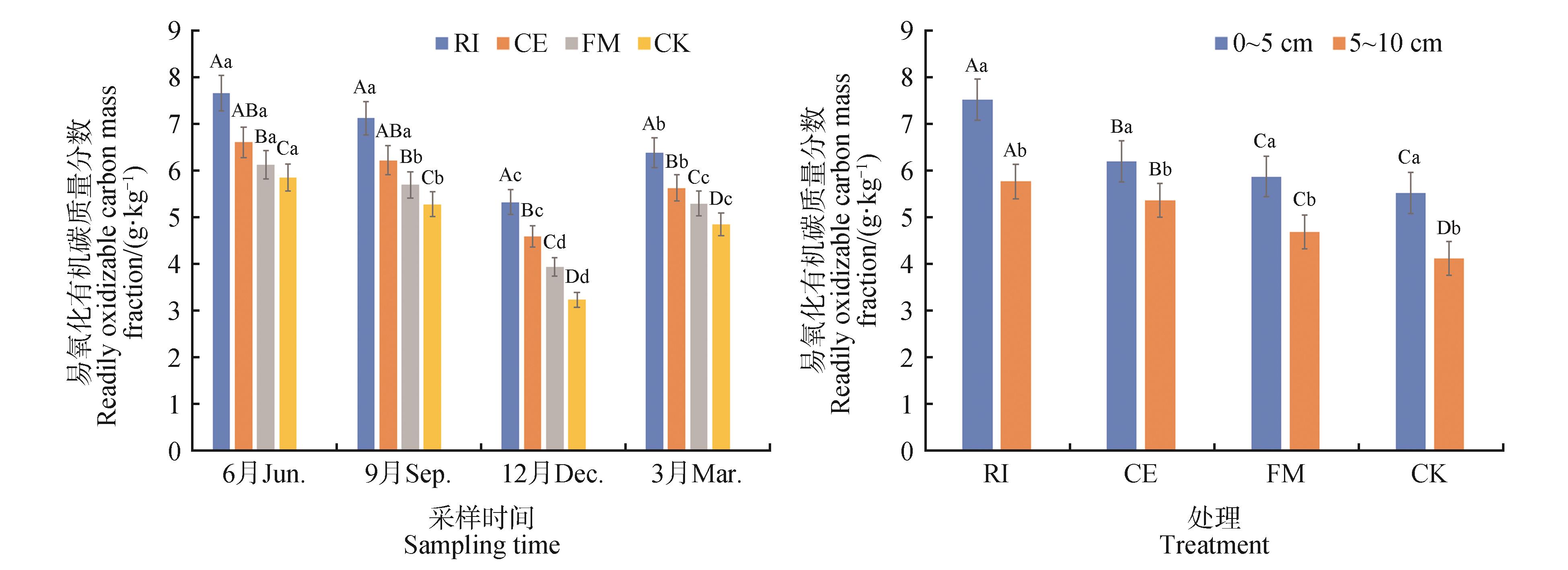

Fig.2
Temporal and spatial changes of total organic carbon in soil under different fungal inoculation treatmentsDifferent capital letters indicated significant differences among different fungal inoculation treatments in the same sampling time or soil layer(P<0.05), and different lowercase letters indicated significant differences among sampling time or soil layer conditions in the same inoculation treatment(P<0.05).
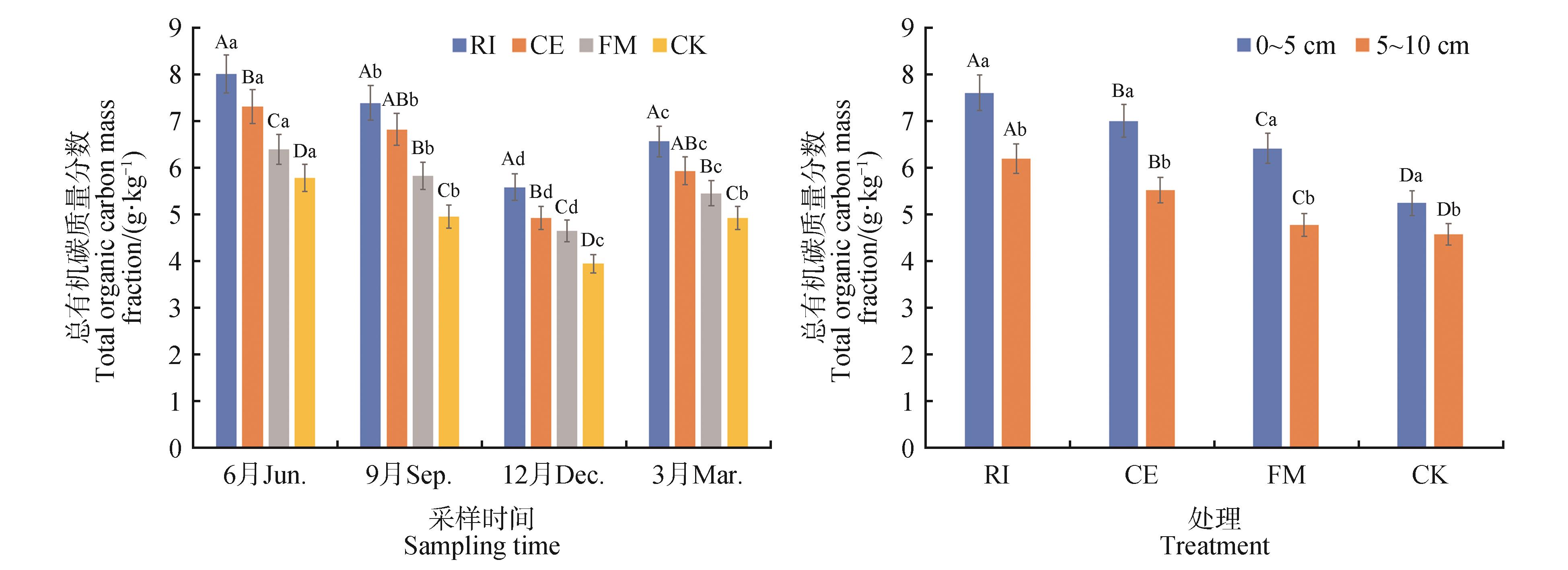

Fig.3
Temporal and spatial changes of soil microbial biomass carbon under different fungal inoculation treatmentsDifferent capital letters indicated significant differences among different fungal inoculation treatments in the same sampling time or soil layer(P<0.05), and different lowercase letters indicated significant differences among sampling time or soil layer conditions in the same inoculation treatment(P<0.05).
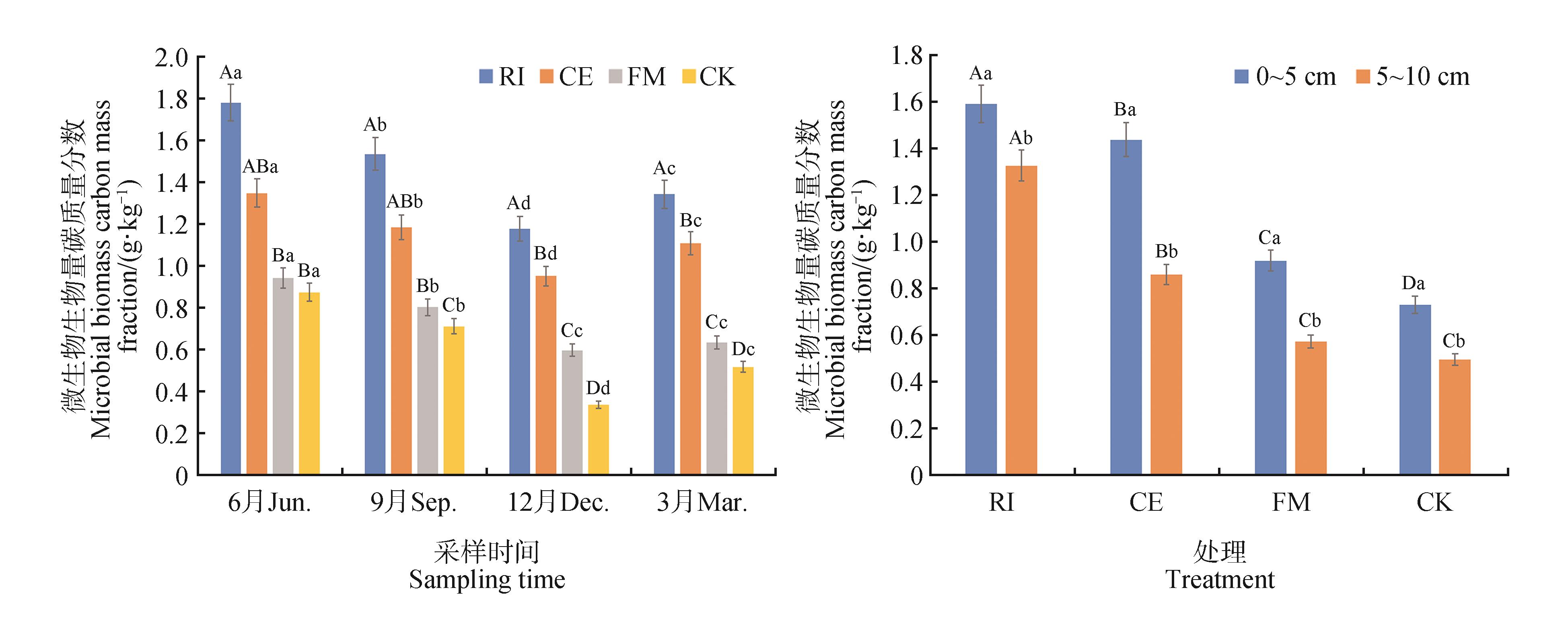
Table 2
Colonization rate, hyphae density,and soil property changes under inoculation with AM fungi
接种处理 Inoculation treatment | 全磷 TP/(g·kg-1) | 有机质 SOM/(g·kg-1) | 土壤含水量 SWC/% | 有效磷 AP/(g·kg-1) | 速效钾 AK/(g·kg-1) | 容重 BD/(g·cm-3) | pH | 全氮 TN/(g·kg-1) | 水解氮 HN/(mg·kg-1) | 铵氮 AN/(mg·kg-1) | 硝氮 NN/(mg·kg-1) | 侵染率 RC/% | 菌丝密度 HLD/(mg·kg-1) |
|---|---|---|---|---|---|---|---|---|---|---|---|---|---|
| CE | 1.70±0.14ab | 10.76±0.53b | 11.00±0.04b | 6.02±0.56ab | 40.75±0.80ab | 1.52±0.09c | 7.52±0.03b | 5.03±0.27ab | 60.24±0.36b | 3.01±0.51b | 14.23±0.80b | 75.52±0.41b | 2.76±0.07b |
| FM | 1.28±0.46b | 10.51±0.98b | 9.30±0.41c | 5.24±0.74b | 37.57±0.72b | 1.59±0.06b | 7.91±0.25a | 4.71±0.38b | 52.54±0.61c | 2.74±0.36c | 13.92±0.67b | 57.82±0.57c | 2.32±0.09c |
| RI | 1.80±0.36a | 12.42±0.71a | 12.78±0.29a | 6.84±0.82a | 41.15±0.49a | 1.49±0.07d | 7.05±0.04c | 5.46±0.45a | 76.52±0.53a | 4.57±0.79a | 16.18±0.41a | 90.39±0.76a | 3.87±0.08a |
| CK | 0.81±0.12c | 8.79±0.80c | 5.65±0.28d | 4.82±0.67c | 30.84±0.52c | 1.83±0.10a | 7.93±0.04a | 1.30±0.03c | 33.45±0.41d | 2.00±0.48d | 11.11±0.69c | 33.77±0.50d | 1.81±0.08d |
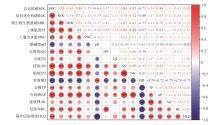
Fig.5
Correlation analysis of soil total organic carbon with colonization rate, hyphal lodge density, and soil physical and chemical properties under inoculation with different AM fungi* indicated P<0.05, ** indicated P<0.001; red color represented positive correlation, the darker the color, the stronger the positive correlation; blue color represented negative correlation, the darker the color, the stronger the negative correlation. The larger the sphere, the greater the correlation value.

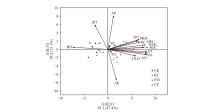
Fig.6
Principal component analysis showing the relationship between total soil organic carbon and soil physicochemical properties under inoculation with different AM fungiAK. Available kalium; AN. Ammonium nitrogen; AP. Available phosphorus; BD. Bulk density; HLD. Hyphal lodge density; HN. Hydrolyzable nitrogen; MBC. Microbial biomass carbon; NN. Nitrate nitrogen; pH. Potential of hydrogen; ROC. Readily oxidizable organic carbon; SOC. Total soil organic carbon; ST. Soil temperature; SWC. Soil water content; TN. Total nitrogen; TP. Total phosphorus.

| 1 | SCHLESINGER W H.Biogeochemistry:an analysis of global change[M].2nd ed.San Diego:Academic Press,1997. |
| 2 | POST W M, EMANUEL W R, ZINKE P J,et al.Soil carbon pools and world life zones[J].Nature,1982,298(5870):156-159. |
| 3 | 刘苗,刘国华.土壤有机碳储量估算的影响因素和不确定性[J].生态环境学报,2014,23(7):1222-1232. |
| LIU M, LIU G H.Impact factors and uncertainties of the estimation on soil organic carbon storage[J].Ecology and Environmental Sciences,2014,23(7):1222-1232. | |
| 4 | 赵广,张扬建.大气CO2浓度升高对土壤碳库稳定性的影响[J].生态学报,2023,43(20):8493-8503. |
| ZHAO G, ZHANG Y J.Effect of elevated CO2 on the persistence of soil carbon pool[J].Acta Ecologica Sinica,2023,43(20):8493-8503. | |
| 5 | 左倩倩,王邵军,陈闽昆,等.土壤碳矿化对西双版纳热带森林恢复演替的响应[J].生态环境学报,2020,29(7):1318-1325. |
| ZUO Q Q, WANG S J, CHEN M K,et al.Response of soil carbon mineralization to restoration succession of Xishuangbanna tropical forests[J].Ecology and Environmental Sciences,2020,29(7):1318-1325. | |
| 6 | 王郑钧,王邵军,肖博,等.西双版纳热带森林土壤有机碳积累-分配动态对蚂蚁筑巢活动的响应[J].生态环境学报,2024,33(1):35-44. |
| WANG Z J, WANG S J, XIAO B,et al.Response of soil organic carbon accumulation and allocation dynamics to ant nesting activities in Xishuangbanna tropical forests[J].Ecology and Environmental Sciences,2024,33(1):35-44. | |
| 7 | 杨漫婷,郑美扬,林松,等.梅花鹿长期活动对植物群落及土壤有机碳累积变化的影响[J].应用生态学报,2025,36(3):811-818. |
| YANG M T, ZHENG M Y, LIN S,et al.Long-term impacts of Cervus nippon on plant community and soil organic carbon accumulation[J].Chinese Journal of Applied Ecology,2025,36(3):811-818. | |
| 8 | 武文卓,任倩茹,张仕琪,等.芦芽山森林和草地不同深度土壤有机碳库结构与稳定性[J/OL].环境科学,(2024-12-25)[2025-01-22].. |
| WU W Z, REN Q R, ZHANG S Q,et al.Structure and stability of soil organic carbon pools along depths in forests and grasslands in Luya Mountain [J/OL].Environmental Science,(2024-12-25)[2025-01-22].. | |
| 9 | 喻志,梁坤南,黄桂华,等.丛枝菌根真菌对植物抗旱性研究进展[J].草业科学,2021,38(4):640-653. |
| YU Z, LIANG K N, HUANG G H,et al.Research progress on the mechanisms of arbuscular mycorrhizal fungi on drought resistance in plants[J].Pratacultural Science,2021,38(4):640-653. | |
| 10 | 王梦洁.黔中喀斯特次生林木本植物物种多样性与地上生物量及其相关性[D].贵阳: 贵州师范大学,2022. |
| WANG M J.Species diversity and above-ground biomass of woody plants of Karst secondary forest and their correlation in central Guizhou [D].Guiyang:Guizhou Normal University,2022. | |
| 11 | 段海霞,罗崇亮,师茜,等.丛枝菌根真菌对植物-土壤系统影响的研究进展[J].生态学报,2025,45(1):475-491. |
| DUAN H X, LUO C L, SHI Q,et al.Research progress in the effects of arbuscular mycorrhizal fungi on plant-soil systems[J].Acta Ecologica Sinica,2025,45(1):475-491. | |
| 12 | 王邵军,左倩倩,曹乾斌,等.云南寻甸石漠化土壤易氧化碳对丛枝菌根真菌共生的响应[J].南京林业大学学报(自然科学版),2022,46(1):7-14. |
| WANG S J, ZUO Q Q, CAO Q B,et al.Response of readily oxidized carbon to arbuscular mycorrhizal(AM) fungi inoculations in rocky desert soil,Xundian,Yunnan Province[J].Journal of Nanjing Forestry University(Natural Sciences Edition),2022,46(1):7-14. | |
| 13 | 向丹,徐天乐,李欢,等.丛枝菌根真菌的生态分布及其影响因子研究进展[J].生态学报,2017,37(11):3597-3606. |
| XIANG D, XU T L, LI H,et al.Ecological distribution of arbuscular mycorrhizal fungi and the influencing factors[J].Acta Ecologica Sinica,2017,37(11):3597-3606. | |
| 14 | 易兴松,戴全厚,严友进,等.西南喀斯特地区耕地撂荒生态环境效应研究进展[J].生态学报,2023,43(3):925-936. |
| YI X S, DAI Q H, YAN Y J,et al.Research progress on the ecological environment effect of farmland abandonment in Karst areas of Southwest China[J].Acta Ecologica Sinica,2023,43(3):925-936. | |
| 15 | 郭应军.喀斯特石漠化治理农村能源结构优化与低碳社区模式[D].贵阳:贵州师范大学,2021. |
| GUO Y J.Optimization of rural energy structure and model of low-carbon community in the Karst rocky desertification control[D].Guiyang:Guizhou Normal University,2021. | |
| 16 | 李廷铃,熊康宁,杨珊,等.喀斯特地区石漠化程度与林分水源涵养的相关性研究[J].四川林业科技,2022,43(1):57-64. |
| LI T L, XIONG K N, YANG S,et al.Study on correlation between rocky desertification degree and forest water conservation in Karst area[J].Sichuan Forestry Science and Technology,2022,43(1):57-64. | |
| 17 | 王邵军,李霁航,陆梅,等.“AM真菌-根系-土壤”耦合作用机制研究进展[J].中南林业科技大学学报,2019,39(12):1-9. |
| WANG S J, LI J H, LU M,et al.Advance on the mechanism of coupling interactions among AM fungi,roots and soils[J].Journal of Central South University of Forestry & Technology,2019,39(12):1-9. | |
| 18 | 肖雪峰.丛枝菌根(AMF)介导下米槁幼苗对干旱胁迫的响应机制研究[D].贵阳:贵州大学,2023. |
| XIAO X F.Research on the response mechanism of Cinnamomum migao seedlings to drought stress mediated by arbuscular mycorrhizal fungi(AMF) [D].Guiyang:Guizhou University,2023. | |
| 19 | 段华超,郑鑫华,李世民,等.云南石漠化地区植被恢复模式及优化建议[J].中国岩溶,2024,43(1):137-146. |
| DUAN H C, ZHENG X H, LI S M,et al.Vegetation restoration model and suggestions for its optimization in rocky desertification areas in Yunnan Province[J].Carsologica Sinica,2024,43(1):137-146. | |
| 20 | 段华超,郑鑫华,李燕燕,等.外源植物激素对白枪杆幼苗生物量分配的影响[J].林业资源管理,2021(3):76-83. |
| DUAN H C, ZHENG X H, LI Y Y,et al.Effect of exogenous plant hormones on biomass allocation of Fraxinus malacophylla seedlings[J].Forest Resources Management,2021(3):76-83. | |
| 21 | WALKLEY A, BLACK I A.An examination of the Degtjareff method for determining soil organic matter,and a proposed modification of the chromic acid titration method[J].Soil Science,1934,37(1):29-38. |
| 22 | 马晗,王小国.氯仿熏蒸对紫色土农田土壤有机碳矿化的影响[J].中国生态农业学报(中英文),2022, 30(11):1819-1826. |
| MA H, WANG X G.Effects of chloroform fumigation on soil organic carbon mineralization in purple soil farmland[J].Chinese Journal of Eco-Agriculture,2022, 30(11):1819-1826. | |
| 23 | 解玲玲,王邵军,肖博,等.土壤碳库积累与分配对热带森林恢复的响应[J].生态学报,2023,43(23):9877-9890. |
| XIE L L, WANG S J, XIAO B,et al.Responses of soil carbon component accumulation and allocation to tropical forest restoration[J].Acta Ecologica Sinica,2023, 43(23):9877-9890. | |
| 24 | BREMNER J M, MULVANEY C S.Nitrogen:total[M]//Page A L.Methods of soil analysis,part 2:chemical and microbiological properties[s.l.]:American Society of Agronomy,Soil Science Society of America,1982:595-624. |
| 25 | 位文涛,李振峰,李林泽,等.微流池多光程土壤有效态氮磷测定方法研究[J].中国无机分析化学,2022,12(5):58-64. |
| WEI W T, LI Z F, LI L Z,et al.Determination of available nitrogen and phosphorus in soil using a micro-tube with multi-optical length[J].Chinese Journal of Inorganic Analytical Chemistry,2022,12(5):58-64. | |
| 26 | 李朝英,郑路,李华.流动分析仪测定土壤有效磷含量的方法[J].中国土壤与肥料,2023(4):238-244. |
| LI Z Y, ZHENG L, LI H.Method for determination of effective phosphorus content in soil by flow analyzer[J].Soil and Fertilizer Sciences in China,2023(4):238-244. | |
| 27 | 李清鑫,张珊,张复茂,等.基于文献计量学的植物地下碳输入对土壤有机碳贡献的研究进展[J].土壤通报,2024,55(6):1777-1788. |
| LI Q X, ZHANG S, ZHANG F M,et al.Research progress on the contribution of plant belowground carbon input to soil organic carbon based on bibliometrics[J].Chinese Journal of Soil Science,2024,55(6):1777-1788. | |
| 28 | 张睿博,汪金松,王全成,等.土壤颗粒态有机碳与矿物结合态有机碳对气候变暖响应的研究进展[J].地理科学进展,2023,42(12):2471-2484. |
| ZHANG R B, WANG J S, WANG Q C,et al.Responses of soil particulate and mineral-associated organic carbon to climate warming:a review[J].Progress in Geography,2023,42(12):2471-2484. | |
| 29 | 纪玲玲.AM真菌驱动的土壤团聚体形成过程与稳定机制[D].武汉:华中农业大学,2020. |
| JI L L.The formation and stabilization mechanisms of soil aggregates driven by arbuscular mycorrhizal fungi[D].Wuhan:Huazhong Agricultural University,2020. | |
| 30 | 任闻达.AM真菌和物种丰富度调控斑块异质性土壤理化性质研究[D].贵阳:贵州大学,2022. |
| REN W D.Research on AM fungi and species richness in regulating patch heterogeneity of soil physical and chemical properties[D].Guiyang:Guizhou University,2022. | |
| 31 | 李瑞,王邵军,兰梦杰,等.石漠化土壤碳矿速率对丛枝菌根真菌接种的响应[J].生态环境学报,2024,33(10):1506-1515. |
| LI R, WANG S J, LAN M J,et al.Response of soil carbon mineral rate in rocky desertification to arbuscular mycorrhizal fungi inoculation[J].Ecology and Environmental Sciences,2024,33(10):1506-1515. | |
| 32 | 王娇月,宋长春,王宪伟,等.冻融作用对土壤有机碳库及微生物的影响研究进展[J].冰川冻土,2011,33(2):442-452. |
| WANG J Y, SONG C C, WANG X W,et al.Progress in the study of effect of freeze-thaw processes on the organic carbon pool and microorganisms in soils[J].Journal of Glaciology and Geocryology,2011,33(2):442-452. | |
| 33 | 方晰,陈婵.植被恢复对土壤N、P积累转化及其耦合关系影响的研究进展[J].中南林业科技大学学报,2022,42(2):84-97. |
| FANG X, CHEN C.Research progress on effects of vegetation restoration on soil N and P accumulation,transformation and their coupling[J].Journal of Central South University of Forestry & Technology,2022,42(2):84-97. | |
| 34 | 洪思思,巩合德,朱秀雯,等.西双版纳热带雨林土壤N2O和CO2排放对氮添加的响应[J].西部林业科学,2023,52(3):118-127. |
| HONG S S, GONG H D, ZHU X W,et al.Response of soil N2O and CO2 emissions to nitrogen addition in Xishuangbanna tropical rain forest[J].Journal of West China Forestry Science,2023,52(3):118-127. | |
| 35 | 王邵军,李霁航,陆梅,等.“AM真菌-根系-土壤”耦合作用机制研究进展[J].中南林业科技大学学报,2019,39(12):1-9. |
| WANG S J, LI J H, LU M,et al.Advance on the mechanism of coupling interactions among AM fungi,roots and soils[J].Journal of Central South University of Forestry & Technology,2019,39(12):1-9. | |
| 36 | 何相宜,刘肖肖,戴伟.天山云杉林土壤有机碳矿化特征[J].西北林学院学报,2019,34(2):1-7. |
| HE X Y, LIU X X, DAI W.Mineralization features of Picea schrenkiana forest soil[J].Journal of Northwest Forestry University,2019,34(2):1-7. | |
| 37 | 李雅,卢杰.土壤碳的影响因素及凋落物对土壤碳储量的影响[J].农业与技术,2023,43(4):52-55. |
| LI Y, LU J.Influencing factors of soil carbon and effects of litter on soil carbon storage[J].Agriculture and Technology,2023,43(4):52-55. | |
| 38 | 王健祺,李发东,李俊峰,等.天山北坡玛纳斯河流域土壤有机碳分布特征与影响因素[J].中国生态农业学报(中英文),2025,33(3):449-461. |
| WANG J Q, LI F D, LI J F,et al.Distribution characteristics and influencing factors of soil organic carbon in the Manas River Basin on the northern slope of Tianshan Mountain[J].Chinese Journal of Eco-Agriculture,2025,33(3):449-461. | |
| 39 | 柴锦隆.模拟践踏和降水对高寒草甸土壤理化性质和微生物数量的影响[D].兰州:甘肃农业大学,2018. |
| CHAI J L.Effects of simulated trampling and rainfall on soil physicochemical properties and microorganism abundance in alpine meadow[D].Lanzhou:Gansu Agricultural University,2018. | |
| 40 | 沈鹏,赵桂茹,杨友琼,等.接种AMF与根系分隔对玉米马铃薯间作土壤氮素利用的影响[J].中国土壤与肥料,2022(9):166-173. |
| SHEN P, ZHAO G R, YANG Y Q,et al.Effects of AMF inoculation and root separation on soil nitrogen utilization in maize-potato intercropping[J].Soil and Fertilizer Sciences in China,2022(9):166-173. | |
| 41 | 薛亦康,柳开楼,邬磊,等.长期不同施肥水田和旱地铁氧化物对红壤团聚体有机碳固持特性的影响[J].中国生态农业学报(中英文),2023,31(9):1428-1438. |
| XUE Y K, LIU K L, WU L,et al.Effects of iron oxides on carbon sequestration characteristics of red soil aggregates in paddy fields and upland under varying long-term fertilization practices[J].Chinese Journal of Eco-Agriculture,2023,31(9):1428-1438. | |
| 42 | 夏佳慧,王邵军,罗双,等.蚯蚓与丛枝菌根真菌接种对石漠化土壤碳组分积累与分配的影响[J].应用生态学报,2024,35(8):2176-2186. |
| XIA J H, WANG S J, LUO S,et al.Effects of earthworm and arbuscular mycorrhizal fungal inoculation on carbon component accumulation and allocation in rocky desertification soils[J].Chinese Journal of Applied Ecology,2024,35(8):2176-2186. | |
| 43 | 韩雅璐.伊金霍洛旗不同凋落物对土壤有机碳转化的影响[D].呼和浩特:内蒙古农业大学,2023. |
| HAN Y L.Effects of different litters on soil organic carbon transformation in Eiin Horo Banner[D].Hohhot:Inner Mongolia Agricultural University,2023. | |
| 44 | 张莹,谷海红,艾艳君,等.丛枝菌根真菌对土壤碳平衡的影响研究进展[J/OL].中国农业科技导报,(2024-12-03)[2025-01-22].. |
| ZHANG Y, GU H H, AI Y J,et al.Research progress on effect of arbuscular mycorrhizal fungi on soil carbon balance[J/OL].Journal of Agricultural Science and Technology,(2024-12-03)[2025-01-22].. | |
| 45 | 尚雯,李玉强,韩娟娟,等.围封对流动沙丘表层土壤有机碳、全氮和活性有机碳的影响[J].水土保持学报,2012,26(6):147-152. |
| SHANG W, LI Y Q, HAN J J,et al.Effects of exclosure on topsoil organic carbon,total nitrogen and labile organic carbon of mobile dune in Horqin sandy land[J].Journal of Soil and Water Conservation,2012,26(6):147-152. | |
| 46 | 张晗烁,郑勇,贺纪正.土壤真菌生物地理学研究进 展[J].生态学杂志,2024,43(12):3774-3786. |
| ZHANG H S, ZHENG Y, HE J Z.Research progress on the biogeography of soil fungi[J].Chinese Journal of Ecology,2024,43(12):3774-3786. | |
| 47 | 彭雪,郭二丹,仇莹莹,等.丛枝菌根真菌对药用植物生产的影响研究[J].安徽农业科学,2022,50(21):13-17. |
| PENG X, GUO E D, QIU Y Y,et al.Research on effection of arbuscular mycorrhizal fungi in the production of medicinal plants[J].Journal of Anhui Agricultural Sciences,2022,50(21):13-17. | |
| 48 | 张东来,张玲.阔叶红松林不同演替系列土壤可溶性有机碳含量及影响因素[J].森林工程,2024,40(2):10-16. |
| ZHANG D L, ZHANG L.Soluble organic carbon content and influencing factors in different succession series of broad-leaved Korean pine forests[J].Forest Engineering,2024,40(2):10-16. | |
| 49 | 朱锐.酸化对黑土性质及其呼吸作用影响的模拟研 究[D].长春:吉林农业大学,2012. |
| ZHU R.The simulation study of the acidification of the black soil nature of respiration[D].Changchun:Jilin Agricultural University,2012. | |
| 50 | 李琼香,朱经伟,王新修,等.不同质地黄壤微生物群落特征[J/OL].农业环境科学学报,(2024-12-13)[2025-01-22].. |
| LI Q X, ZHU J W, WANG X X,et al.Characteristics of microbial communities in yellow soil of diverse texture[J/OL].Journal of Agro-Environment Science,(2024-12-13)[2025-01-22].. | |
| 51 | 陆啸飞,郭洁芸,王斌,等.氮添加对中国陆地植被地上-地下生物量分配的影响[J].生态学报,2024,44(4):1313-1323. |
| LU X F, GUO J Y, WANG B,et al.Effects of nitrogen addition on plant above- and below-ground biomass allocation in terrestrial ecosystems in China[J].Acta Ecologica Sinica,2024,44(4):1313-1323. | |
| 52 | 孙学广.AM共生机制研究:AM真菌与植物根系的识别及AM功能相关基因[D].杨凌:西北农林科技大学,2014. |
| SUN X G.Mechanisms of AM symbiosis:recognition between AM fungi and plant roots and characterization of AM functional related genes[D].Yangling:Northwest A&F University,2014. | |
| 53 | 吴静,盛茂银.我国喀斯特植被根系生态学研究进展[J].植物科学学报,2020,38(4):565-573. |
| WU J, SHENG M Y.Research progress in root ecology of Karst vegetation in China[J].Plant Science Journal,2020,38(4):565-573. | |
| 54 | 郭亚兵,毛晋花,王聪,等.氮、磷添加对热带森林土壤氮转化及损失影响的研究进展[J].生态学杂志,2021,40(10):3339-3354. |
| GUO Y B, MAO J H, WANG C,et al.Effects of nitrogen and phosphorus addition on soil nitrogen transformation and loss in tropical forests:a review[J].Chinese Journal of Ecology,2021,40(10):3339-3354. | |
| 55 | 任义芳,贾明强,刘润进.菌根真菌与其他生物联合修复污染与退化土壤的效应与机制[J].青岛农业大学学报(自然科学版),2014,31(4):235-241 |
| REN Y F, JIA M Q, LIU R J.Effects and mechanisms of combined remediating polluted and degraded soil with mycorrhizal fungi and other living organisms[J].Journal of Qingdao Agricultural University(Natural Science),2014,31(4):235-241. |
| [1] | HE Yue-Jun;ZHONG Zhang-Cheng*. Drought Resistance of Cinnamomum camphora Seedlings Inoculated with Different AM Fungi in Karst Soil [J]. Bulletin of Botanical Research, 2011, 31(5): 597-602. |
| Viewed | ||||||
|
Full text |
|
|||||
|
Abstract |
|
|||||